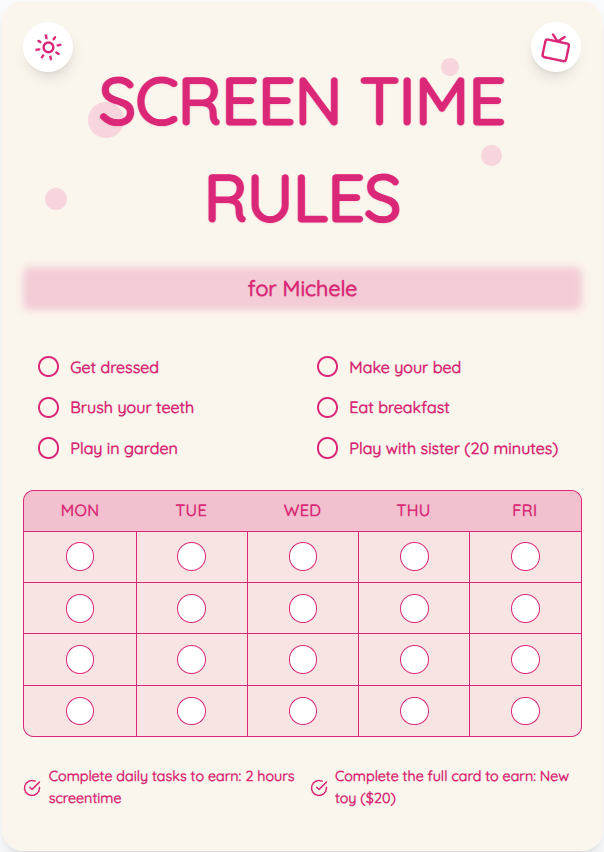Effective Screen Time Guidelines for Parents in New Zealand
As a parent in New Zealand, navigating the digital landscape can be challenging. Finding the right balance for your child's screen time is crucial for their overall well-being and development. Here, we provide expert advice and practical tips to help you set healthy screen time guidelines for your kids aged 2-12.
See What Your Screen Time Chart Will Look Like
Here's an example of a beautiful, customizable screen time rules chart you can create for your family

Understanding Screen Time Recommendations in NZ
In New Zealand, like many other countries, there are recommended guidelines for children's screen time. The Ministry of Health suggests limiting recreational screen time to no more than 1-2 hours a day for children aged 2-5. For older children aged 5-12, the recommendation is to limit recreational screen time to no more than 2 hours a day. These guidelines aim to promote physical activity, quality sleep, and healthy social interactions.
Practical Tips for Managing Screen Time
1. Create a screen time schedule: Set specific times when screens are allowed and stick to them. 2. Use screen time as a reward: Encourage good behavior by offering screen time as a reward for completing chores or homework. 3. Engage in screen time together: Watch shows or play games with your child to monitor content and promote bonding. 4. Encourage outdoor activities: Limit screen time by encouraging outdoor play and other offline activities.
Put These Tips Into Action
Create a custom chart to implement these strategies with your child
Setting Boundaries and Consistency
Consistency is key when it comes to screen time rules. Clearly communicate the guidelines to your child and ensure that all caregivers follow them consistently. Setting boundaries will help your child understand the importance of moderation and balance in screen use.
Monitoring Content and Screen Time Apps
Utilize parental control settings on devices to monitor the content your child accesses. Additionally, consider using screen time management apps that allow you to set time limits and track usage. These tools can help you enforce the guidelines you've set and promote a healthy digital environment for your child.
Practical Tips for Success
- Create a family media plan together with your child.
- Encourage alternative activities like reading, arts and crafts, or sports.
- Lead by example by managing your own screen time usage.
- Discuss the importance of balance and moderation with your child.
Frequently Asked Questions
How can excessive screen time impact my child's development?
Excessive screen time has been linked to various negative effects on children, including decreased physical activity, disrupted sleep patterns, poor academic performance, and behavioral issues. By setting limits and monitoring content, you can mitigate these risks.
What are some signs that my child may be spending too much time on screens?
Signs that your child may be spending too much time on screens include irritability when not allowed screen time, neglecting other activities they used to enjoy, declining academic performance, and difficulty focusing or sleeping.
How can I encourage my child to reduce screen time without conflict?
Open communication is key. Explain the reasons behind the guidelines you've set and involve your child in creating a screen time schedule. Offer alternative activities and incentives for reducing screen time, and lead by example by limiting your own screen use.
By implementing these practical tips and guidelines, you can create a healthy balance between screen time and other activities for your child. Remember, moderation is key in fostering their well-being and development. Visit ScreenTimeRules.com to generate personalized screen time charts tailored to your family's needs.
Ready to Transform Your Family's Screen Time?
Join thousands of parents who have successfully managed screen time with our customizable charts.
